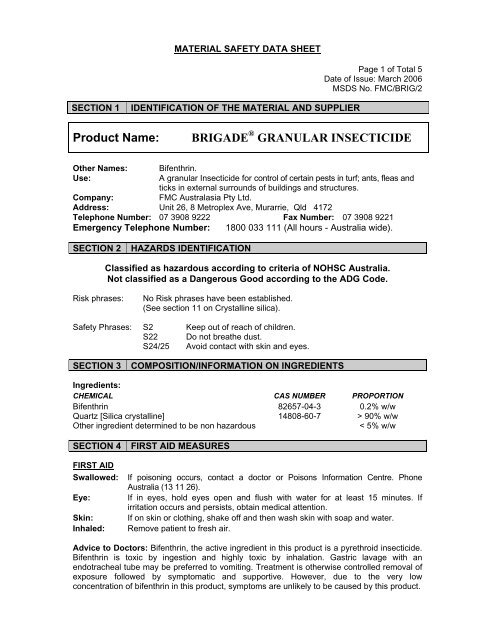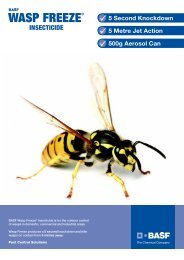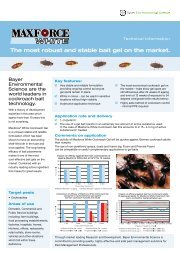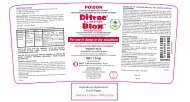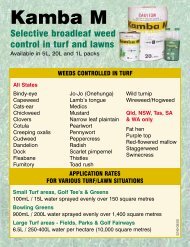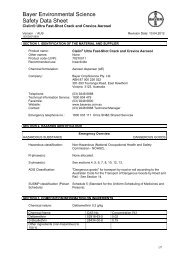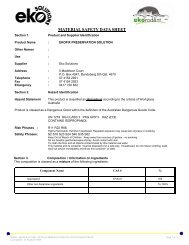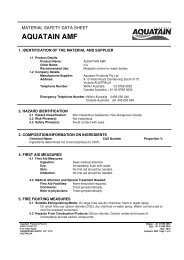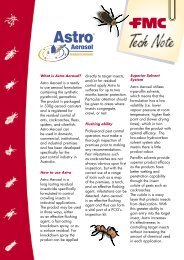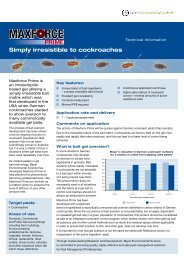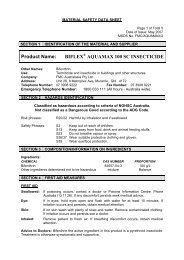Product Name: BRIGADE GRANULAR INSECTICIDE - Garrards
Product Name: BRIGADE GRANULAR INSECTICIDE - Garrards
Product Name: BRIGADE GRANULAR INSECTICIDE - Garrards
Create successful ePaper yourself
Turn your PDF publications into a flip-book with our unique Google optimized e-Paper software.
MATERIAL SAFETY DATA SHEET<br />
SECTION 1 IDENTIFICATION OF THE MATERIAL AND SUPPLIER<br />
Page 1 of Total 5<br />
Date of Issue: March 2006<br />
MSDS No. FMC/BRIG/2<br />
<strong>Product</strong> <strong>Name</strong>: <strong>BRIGADE</strong> ® <strong>GRANULAR</strong> <strong>INSECTICIDE</strong><br />
Other <strong>Name</strong>s: Bifenthrin.<br />
Use: A granular Insecticide for control of certain pests in turf; ants, fleas and<br />
ticks in external surrounds of buildings and structures.<br />
Company: FMC Australasia Pty Ltd.<br />
Address: Unit 26, 8 Metroplex Ave, Murarrie, Qld 4172<br />
Telephone Number: 07 3908 9222 Fax Number: 07 3908 9221<br />
Emergency Telephone Number: 1800 033 111 (All hours - Australia wide).<br />
SECTION 2 HAZARDS IDENTIFICATION<br />
Classified as hazardous according to criteria of NOHSC Australia.<br />
Not classified as a Dangerous Good according to the ADG Code.<br />
Risk phrases: No Risk phrases have been established.<br />
(See section 11 on Crystalline silica).<br />
Safety Phrases: S2 Keep out of reach of children.<br />
S22 Do not breathe dust.<br />
S24/25 Avoid contact with skin and eyes.<br />
SECTION 3 COMPOSITION/INFORMATION ON INGREDIENTS<br />
Ingredients:<br />
CHEMICAL CAS NUMBER PROPORTION<br />
Bifenthrin 82657-04-3 0.2% w/w<br />
Quartz [Silica crystalline] 14808-60-7 > 90% w/w<br />
Other ingredient determined to be non hazardous < 5% w/w<br />
SECTION 4 FIRST AID MEASURES<br />
FIRST AID<br />
Swallowed: If poisoning occurs, contact a doctor or Poisons Information Centre. Phone<br />
Australia (13 11 26).<br />
Eye: If in eyes, hold eyes open and flush with water for at least 15 minutes. If<br />
irritation occurs and persists, obtain medical attention.<br />
Skin: If on skin or clothing, shake off and then wash skin with soap and water.<br />
Inhaled: Remove patient to fresh air.<br />
Advice to Doctors: Bifenthrin, the active ingredient in this product is a pyrethroid insecticide.<br />
Bifenthrin is toxic by ingestion and highly toxic by inhalation. Gastric lavage with an<br />
endotracheal tube may be preferred to vomiting. Treatment is otherwise controlled removal of<br />
exposure followed by symptomatic and supportive. However, due to the very low<br />
concentration of bifenthrin in this product, symptoms are unlikely to be caused by this product.
<strong>Product</strong> <strong>Name</strong>: <strong>BRIGADE</strong> <strong>GRANULAR</strong><br />
<strong>INSECTICIDE</strong><br />
SECTION 5 FIRE FIGHTING MEASURES<br />
Page 2 of Total 5<br />
Issued: March 2006<br />
FMC/BRIG/2<br />
Specific Hazard: <strong>Product</strong> is slightly combustible. May support combustion at elevated<br />
temperatures.<br />
Extinguishing media: Foam, CO2 or dry chemical. Soft stream water fog if no alternatives.<br />
Contain all runoff.<br />
Hazards from combustion products: On burning will emit toxic fumes of carbon monoxide,<br />
carbon dioxide, hydrogen chloride and hydrogen fluoride etc.<br />
Precautions for fire-fighters and special protective equipment: Isolate fire area. Evacuate<br />
downwind. Wear full protective clothing and self-contained breathing apparatus. Do not<br />
breathe or contact smoke, gases or vapours generated.<br />
SECTION 6 ACCIDENTIAL RELEASE MEASURES<br />
Emergency procedures: Isolate and post spill area. Keep out unprotected persons and<br />
animals. Wear prescribed protective clothing and equipment. Large spills should be dyked and<br />
covered to prevent dispersal. Keep material out of streams and sewers. Vacuum, shovel or<br />
pump spilled material into an approved container and if unable to use as directed on the label,<br />
dispose of as listed in section 13.<br />
Material and methods for containment and cleanup procedures: To clean spill area, tools<br />
and equipment, wash with a solution of caustic or soda ash and an appropriate alcohol<br />
(methanol, ethanol or isopropanol). Follow this by washing with a strong soap and water<br />
solution. Absorb any excess liquid and add to drums of waste that cannot be re-used.<br />
Do NOT allow spilled product or wash solution to enter sewers, drains, dams, creeks or any<br />
other waterways.<br />
SECTION 7 HANDLING AND STORAGE<br />
Precautions for Safe Handling: Ensure containers are kept closed until using product. Avoid<br />
skin and eye contact. Do not breathe dust. When opening the container and using granules,<br />
wear cotton overalls buttoned to the neck and wrist (or equivalent clothing).<br />
Conditions for Safe Storage: Store in the closed original container, in a cool well ventilated<br />
area, out of direct sunlight. Keep away from domestic pets, especially dogs. If dogs eat the<br />
granules, contact your veterinary surgeon immediately.<br />
SECTION 8 EXPOSURE CONTROLS / PERSONAL PROTECTION<br />
National Exposure Standards:<br />
No NOHSC Australia exposure standard has been established for bifenthrin. The following<br />
standard may apply to the product:<br />
Atmospheric Contaminant Exposure Standard (TWA) a STEL<br />
Silica Crystalline (quartz) 0.1 mg/m³ -<br />
a = TWA - Time-weight Average b = STEL - Short Term Exposure Standard<br />
Biological Limit Values:<br />
No biological limit allocated.<br />
Engineering controls:<br />
Use in a ventilated area only. Ventilate all transport vehicles prior to unloading. Keep containers<br />
close when not in use.
<strong>Product</strong> <strong>Name</strong>: <strong>BRIGADE</strong> <strong>GRANULAR</strong><br />
<strong>INSECTICIDE</strong><br />
Page 3 of Total 5<br />
Issued: March 2006<br />
FMC/BRIG/2<br />
Personal Protective equipment (PPE):<br />
Work Clothing: Depending on circumstances encountered, wear long sleeve uniform or<br />
overalls. Launder all clothes before reuse.<br />
Eye Protection: Where potential for dust exists, wear chemical protective goggles or a face<br />
shield.<br />
Respiratory Protection: For dust exposure wear a properly fitted half face or full face air<br />
purifying respirator. Respirator selection is based on airborne concentrations.<br />
Gloves: Wear chemical protective gloves made of materials such as PVC, rubber or neoprene.<br />
Wash the outside of gloves with soap and water prior to removal. Inspect regularly for leaks.<br />
Personal Hygiene: Clean water should be available for washing in case of eye or skin<br />
contamination. Wash skin before eating, drinking or smoking. Shower at the end of the workday.<br />
SECTION 9 PHYSICAL AND CHEMICAL PROPERTIES<br />
Appearance: Tan, solid granules.<br />
Odour: Slightly musty odour.<br />
Boiling point: Not available.<br />
Freezing point: Not available.<br />
Bilk Density: 1.39 g/mL.<br />
Solubility in Water: Not soluble.<br />
Flammability: May support combustion at elevated temperatures.<br />
Corrosive hazard: Non corrosive; compatible with stainless steel, glass & aluminium.<br />
Flashpoint (°C) : Not applicable - granule.<br />
Flammability Limits (%): Not established.<br />
Poisons Schedule: <strong>Product</strong> is a not a scheduled poison.<br />
SECTION 10 STABILITY AND REACTIVITY<br />
<strong>Product</strong> is considered stable in ambient conditions for a period of at least 2 years after<br />
manufacture.<br />
SECTION 11 TOXICOLOGICAL INFORMATION<br />
Potential Health Effects:<br />
Studies with laboratory animals have shown this product to have low acute toxicity. Ingestion of<br />
large doses of bifenthrin (the active ingredient in this product) by laboratory animals produced<br />
signs of toxicity which included clonic convulsions, tremors and bloody nasal discharge. This<br />
product has only a very low proportion of bifenthrin (0.2%), and these symptoms are unlikely to be<br />
caused by this product.<br />
Acute<br />
Swallowed: This product has low oral toxicity. Acute Oral LD50 (rat) > 5000 mg/kg.<br />
Eye: Non-irritating to the eye. Excessive exposure to granules may cause irritation to<br />
the eyes. This product contains a granular material (sand) that may cause<br />
mechanical irritation to the eyes.<br />
Skin: Non-irritating to the skin. Acute Dermal LD50 (rabbit) > 2000 mg/kg.<br />
Inhaled: As this product is a granule it is unlikely to be an inhalation hazard.<br />
Chronic: No data available on this formulation. In studies with laboratory animals, Bifenthrin<br />
Technical (the active ingredient in this product) did not cause teratogenicity or reproductive<br />
toxicity. Tremors were associated with repeated exposure of dogs, rats, rabbits, and mice to<br />
bifenthrin. The overall results from a battery of genotoxicity studies indicate that bifenthrin is<br />
not considered to be genotoxic. Ames test results were negative.
<strong>Product</strong> <strong>Name</strong>: <strong>BRIGADE</strong> <strong>GRANULAR</strong><br />
<strong>INSECTICIDE</strong><br />
SECTION 11 TOXICOLOGICAL INFORMATION (Continued)<br />
Page 4 of Total 5<br />
Issued: March 2006<br />
FMC/BRIG/2<br />
Crystalline silica - also known as silicon dioxide (SiO2) - is the basic component of sand,<br />
quartz and granite rock and is found in varying proportions in aggregates, sand, mortar,<br />
concrete and stone, and is also in the air and the soil. Processes which may give rise to<br />
airborne concentrations of crystalline silica dust include hard rock mining, excavation,<br />
tunnelling and earthworks, construction, foundry operations, ceramics production, stone<br />
works, refractory brick production, abrasive blasting, agricultural ploughing and harvesting,<br />
and the production of asphalt, agricultural chemicals, abrasives, glass and paint. If the dust<br />
given off from working with these materials is fine enough to be breathed into the lungs, it is<br />
termed "respirable". Certain exposures to crystalline silica can cause serious harm to human<br />
health. Prolonged exposure to respirable crystalline silica can cause silicosis.<br />
NOHSC have classified crystalline silica as a hazardous substance, but have not given a<br />
classification and have not allocated Risk phrases for this substance.<br />
SECTION 12 ECOLOGICAL INFORMATION<br />
Environmental Toxicology: Bifenthrin is highly toxic to fish and aquatic arthropods with LC50<br />
values ranging from 0.0038 µg/L to 17.8 µg/L. In general, the aquatic arthropods are the most<br />
sensitive species. Care should be taken to avoid contamination of the aquatic environment.<br />
Bifenthrin had no effect on molluscs at its limit of water solubility. Bifenthrin is only slightly toxic to<br />
both waterfowl and upland game birds (LC50 values range from 1800 mg/kg to > 2,150 mg/kg).<br />
Physical/Environmental Properties: No data is available on Brigade Granular Insecticide. The<br />
active ingredient, bifenthrin (0.2%), degrades at a moderate rate in soils (t½ = 50 to 205 days),<br />
and more rapidly on the surface of bare soils (t½ = 7 to 62 days). Bifenthrin is tightly bound in<br />
most soils and an extremely low water solubility. Bifenthrin is highly toxic to aquatic<br />
organisms.<br />
SECTION 13 DISPOSAL CONSIDERATIONS<br />
Spills & Disposal: In the case of spillage contain spilled material by dyking. Dispose of waste<br />
as indicated below or according to the Australian Standard 2507 - Storage and Handling of<br />
Pesticides. Wear prescribed protective clothing and equipment. Keep material out of streams<br />
and sewers. Vacuum, shovel or pump waste into an approved drum. To decontaminate spill<br />
area, tools and equipment, wash with a suitable solution (ie organic solvent, detergent, bleach<br />
or caustic) and add the solution to the drums of wastes already collected. Label for contents.<br />
Dispose of drummed wastes, including decontamination solution, in accordance with the<br />
requirements of Local or State Waste Management Authorities.<br />
Dangerous to Fish: Do NOT allow spilled product or wash solution to enter sewers, drains, dams,<br />
creeks or any other waterways.<br />
Puncture, shred or bury empty containers in a local authority landfill. If not available bury the<br />
containers below 500 mm in a disposal pit specifically marked and set up for this purpose<br />
clear of waterways, vegetation and roots. Empty containers and product should not be burnt.<br />
SECTION 14 TRANSPORT INFORMATION<br />
Road & Rail Transport: Brigade Granular Insecticide is not classified as Dangerous Goods<br />
under the Australian Code for the Transport of Dangerous Goods by Road and Rail.
<strong>Product</strong> <strong>Name</strong>: <strong>BRIGADE</strong> <strong>GRANULAR</strong><br />
<strong>INSECTICIDE</strong><br />
SECTION 14 TRANSPORT INFORMATION (Continued)<br />
Page 5 of Total 5<br />
Issued: March 2006<br />
FMC/BRIG/2<br />
Marine and Air Transport: Brigade Granular Insecticide is a Marine Pollutant according to<br />
International Maritime Dangerous Goods (IMDG) Code and the International Air Transport<br />
Association (IATA). If transporting by sea or air the following Dangerous Goods Classification<br />
applies:<br />
UN 3077, Class 9 (Miscellaneous Dangerous Goods), Packing Group III, Proper Shipping<br />
<strong>Name</strong> ENVIRONMENTALLY HAZARDOUS SUBSTANCE, SOLID, N.O.S. (Contains 0.2%<br />
bifenthrin).<br />
SECTION 15 REGULATORY INFORMATION<br />
Classified as a hazardous substance according to criteria of NOHSC Australia, but no<br />
classification or risk phrases have been established.<br />
Under the Standard for Uniform Scheduling of Drugs and Poisons (SUSDP No. 20), this<br />
product is a not a scheduled poison.<br />
This product is registered under the Agricultural and Veterinary Chemicals Code Act 1994.<br />
<strong>Product</strong> Registration No. 52791.<br />
<strong>Product</strong> is not classified as a Dangerous Good according to the ADG Code (6 th Ed).<br />
<strong>Product</strong> is classified as a Dangerous Good according to International Maritime Dangerous<br />
Goods (IMDG) Code and the International Air Transport Association (IATA).<br />
SECTION 16 OTHER INFORMATION<br />
Issue Date: 13 March 2006 (revised to 16 section format, updated exposure standard, new<br />
company name and corrected minor typographical errors).<br />
Key to abbreviations and acronyms used in this MSDS:<br />
Genotoxic Capable of causing damage to genetic material, such as DNA.<br />
Oedema Accumulation of fluid in tissues.<br />
ADG Code Australian Dangerous Goods Code (for the transport of dangerous goods by<br />
Road and Rail).<br />
NOHSC National Occupational Health and Safety Commission.<br />
PPE Personal protective equipment.<br />
References<br />
1. “Search Hazardous Substances”. HSIS NOHSC Australia website. (2006).<br />
2. “Approved Criteria for Classifying Hazardous Substances” 3rd Ed. NOHSC Australia.<br />
[NOHSC:1008 (2004)]. October 2004.<br />
This MSDS summarises our best knowledge of the health and safety hazard information of the product<br />
and how to safely handle and use the product in the workplace. Each user should read this MSDS and<br />
consider the information in the context of how the product will be handled and used in the workplace<br />
including in conjunction with other products.<br />
If clarification or further information is needed to ensure that an appropriate risk assessment can be<br />
made, the user should contact this company.<br />
End MSDS


